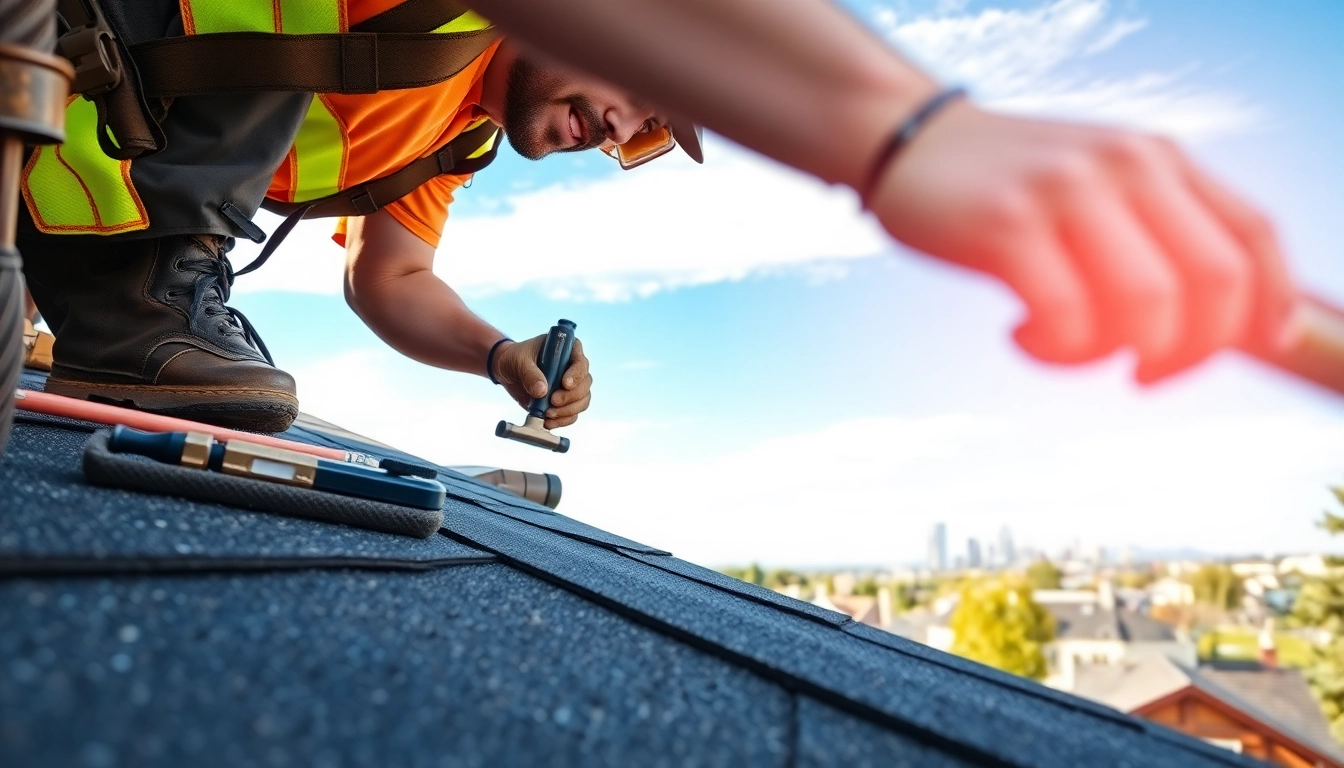Understanding Roofing Replacement Portland Oregon
When it comes to home improvement projects, few are as crucial as roofing replacement. For homeowners in the Pacific Northwest, particularly in Roofing Replacement Portland Oregon, understanding the reasons and processes behind a roof replacement can save both time and money. Your roof is not just a top covering; it serves as your home’s first line of defense against the unpredictable Oregon weather, including heavy rainfall and occasional storms.
What is Roofing Replacement?
Roofing replacement refers to the complete removal of an existing roof and the installation of a new one. This process can involve multiple steps, including assessment, material selection, and installation. It’s essential for maintaining the structural integrity of your home and ensuring the safety of its inhabitants. Unlike minor repairs or maintenance, which may address localized issues, roofing replacement aims to rejuvenate the entire roof system, offering long-term protection and value.
Signs You Need a Roof Replacement
Identifying when your roof needs replacement is critical for effective home maintenance. Here are several key indicators:
- Age of the Roof: Most roofs last between 20 to 25 years. If your roof is approaching this age, it may be time to consider a replacement.
- Visible Damage: Missing shingles, cracked tiles, or significant rust on metal roofs are clear signs that replacement may be necessary.
- Leaks or Water Damage: Water stains on ceilings or walls often indicate that your roof is failing. If leaks are frequent, a replacement is likely needed.
- Shingle Granules: If you notice an increase in granules in your gutters, it suggests that your shingles may be deteriorating.
- Roof Sagging: A sagging or uneven roof often means structural problems that can necessitate a full replacement.
Benefits of Roofing Replacement
Investing in roofing replacement can yield numerous benefits for homeowners:
- Improved Safety: A new roof significantly reduces the risk of leaks and structural failure, providing a safer living environment.
- Enhanced Energy Efficiency: Modern roofing materials offer better insulation, potentially lowering energy bills by improving temperature regulation within the home.
- Increased Property Value: A fresh roof can enhance your home’s curb appeal and market value, making it more attractive to potential buyers.
- Peace of Mind: Knowing your roof is in excellent condition can alleviate worries about weather-related damage.
Choosing the Right Materials for Roofing Replacement Portland Oregon
Selecting the right materials for your roofing replacement is a pivotal decision that can affect longevity, aesthetics, and maintenance costs. With a variety of options available, understanding the benefits and drawbacks of each can help guide your choice.
Popular Roofing Materials Explained
Here are some of the most commonly used roofing materials in Portland:
- Asphalt Shingles: Affordable and versatile, asphalt shingles are the most popular choice among homeowners. They come in a variety of colors and styles and are relatively easy to install.
- Metal Roofing: Known for their durability and energy efficiency, metal roofs can last up to 50 years. They are resistant to severe weather but may require specialized installation.
- Slate and Tile: While these materials are more expensive, they offer incredible longevity and a unique aesthetic appeal. They are perfect for homeowners looking for a high-end aesthetic.
- Wood Shakes and Shingles: Providing natural insulation, wood roofs can enhance a home’s appearance. However, they require more maintenance and are less fire-resistant than other options.
- EPDM and TPO (for flat roofs): These materials are ideal for commercial buildings but are increasingly being used in residential applications. They are affordable and offer excellent waterproofing capabilities.
Eco-Friendly Options for Roof Replacement
For environmentally conscious homeowners, several roofing options can minimize ecological impact while still providing great functionality:
- Recycled Shingles: Made from recycled materials, these shingles are an eco-friendly option that offers durability and requires less new material.
- Green Roofs: These roofs utilize vegetation and living plants, providing insulation and reducing rainwater runoff while enhancing urban biodiversity.
- Cool Roofs: Designed to reflect sunlight rather than absorb it, cool roofs can lower ambient temperature and reduce energy costs. This is an especially useful feature in warm weather.
Cost Comparison of Roofing Materials
Understanding the costs associated with various roofing materials can help homeowners budget for their roofing replacement projects effectively. Here’s a general breakdown:
- Asphalt Shingles: $90 to $100 per square (100 sq ft)
- Metal Roofing: $150 to $600 per square
- Slate Tile: $600 to $1,500 per square
- Wood Shakes/Shingles: $300 to $600 per square
- EPDM: $300 to $500 per square
These costs can vary widely based on factors like local market conditions, labor costs, and accessibility of materials. Always consult with a professional to get an accurate assessment for your specific project.
Finding Qualified Contractors for Roofing Replacement Portland Oregon
The right contractor can make all the difference in the quality of your roofing replacement. Here are actionable steps to ensure you find a reputable professional for the job:
Checklist for Hiring a Roofing Contractor
When searching for a qualified contractor, keeping a checklist can help ensure you make an informed decision:
- Verify Credentials: Make sure the contractor is licensed, insured, and bonded. Ask for proof and check their standing with the Better Business Bureau.
- Look for Experience: Contractors with a strong track record in roofing replacement have likely handled various challenges, ensuring your roof will be in good hands.
- Check Reviews: Read online reviews and ask for references from past clients to gauge satisfaction and reliability.
- Written Estimates: Obtain multiple estimates to compare pricing, scope of work, and materials proposed. Avoid going with the lowest bid without thoroughly assessing service quality.
- Warranties: Inquire about roof and labor warranties. Quality contractors often provide warranties to assure the longevity of their work.
Questions to Ask Potential Roofers
Before hiring, ensure you’ve asked the following critical questions:
- What types of roofing materials do you recommend and why?
- How long will the project take from start to finish?
- What is your payment schedule?
- Who will supervise the installation, and will I have a dedicated contact person?
- What steps will you take to protect my property during the project?
Red Flags to Watch Out For
Being aware of warning signs can help you avoid potential pitfalls in selecting a contractor:
- Demanding large upfront payments or full payment before work begins.
- Unable or unwilling to provide written estimates and contracts.
- Lack of local physical office or presence in the community.
- Pressure tactics or urgency to finalize a decision.
- Poor communication or quick, vague answers to important questions.
Planning Your Roofing Replacement Project
A well-planned roofing replacement project can minimize disruptions and ensure a smooth process from start to finish. Here are the essential steps.
Steps Involved in a Roof Replacement
The process typically involves several key phases:
- Initial Assessment: A thorough evaluation of the current roof including inspections for damage and an assessment of structural integrity.
- Choosing Materials: Collaborate with your contractor to select the best roofing material that fits your budget and aesthetic preferences.
- Obtaining Permits: Ensure all required permits are in place before work begins to comply with local regulations.
- Installation: The contractor will typically remove existing roofing materials and install new ones, following safety protocols.
- Final Inspection: After installation, a comprehensive inspection ensures that everything is complete and adheres to the discussed standards.
Permits and Regulations in Portland
Before commencing any roofing replacement project in Portland, it’s essential to understand the local building regulations and obtain necessary permits. The city may require:
- Building permits for full roof replacements, particularly if changing materials.
- Inspections at various stages of the project to ensure compliance with Oregon’s building codes.
Consult your contractor about securing these permits as they are often familiar with the requirements and can manage the process for you.
Preparing Your Home for Roof Replacement
Preparation can significantly impact the success of a roofing replacement project. Here are steps to help you prepare your home:
- Clear the Area: Move vehicles and outdoor furniture away from the work area to prevent damage.
- Notify Your Neighbors: Inform your neighbors about the upcoming work to minimize inconveniences.
- Secure Pets: Keep pets indoors or in a secure area during construction to ensure their safety.
- Stay Home During Critical Phases: Being available during the essential parts of the project can help with communication and quick decision-making as needed.
Maintenance After Roofing Replacement Portland Oregon
Once your new roof is installed, maintaining it is key to extending its lifespan. Proper care can prevent future costs related to repairs or premature replacement.
Routine Inspections and Care
Establishing a routine inspection schedule helps ensure your roof remains in good condition. Here are some best practices:
- Regular Inspections: Conduct inspections every six months, ideally in spring and fall, checking for damage or wear.
- Look for Debris: Clean gutters and downspouts and remove debris from the roof to prevent water retention and moss growth.
- Check for Leaks: Inspect for leaks after heavy rains or snow melts to catch issues early.
Extending the Lifespan of Your New Roof
To ensure your new roof lasts for its expected lifespan, implement the following strategies:
- Use Preventative Treatments: Consider treatments for algae and moss to prevent growth and associated damage.
- Keep Trees Trimmed: Trim any overhanging branches that may scratch the roof or drop debris on it.
- Avoid Pressure Washing: Avoid using high-pressure washing techniques on your roof as this can damage shingles and affect their integrity.
When to Schedule Professional Maintenance
While routine inspections can be done by homeowners, scheduling professional maintenance can provide an in-depth review and care. Consider professional evaluations:
- Annually for aging roofs or if your roof is nearing the end of its lifespan.
- After significant weather events, such as storms, high winds, or heavy snowfall, to assess any damage.
- If you notice creeping issues such as leaks, mold, or mildew inside your home.

